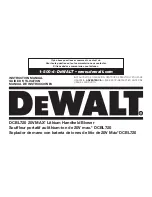
D--9--611 Page 7
SECTION 2
INSTALLATION
LOCATION
Whenever possible, install the blower in a clean and dry
place that is both well lighted and well ventilated.
Provide plenty of room for easy inspection and mainte-
nance.
FOUNDATION AND BASE
For permanent installations we recommend concrete
foundations be provided, and the equipment should be
grouted to the concrete. Use non--shrinking grout only.
It is necessary that a suitable base be used, such as
steel combination base under the blower and motor, or
a separate sole plate under each. The blower feet must
be 100% supported. Before grouting, equipment must
be leveled, free of all strains, and anchored so no
movement will occur during curing of grout. After grout
has completely hardened, a recheck is necessary to
compensate for shrinkage. If required, add shims
under blower feet after final tightening of foundation
anchor bolts to remove strain from the blower housing.
Where jack screws or wedges are used during grout-
ing, they must be backed off or removed before final
tightening of anchor bolts.
Where a concrete foundation is not feasible, care must
be taken to insure that equipment is firmly anchored to
adequate structural members. The blower must be
installed on a flat, level surface and bolted down evenly
to prevent warping or strain. Internal clearances are
very critical and serious damage or failure can result
from housing distortion.
If the unit is not flat within .002 of an
inch, it will be necessary to shim the
blower feet at installation.
MOUNTING CONFIGURATIONS
All DuroFlow blowers are center timed allowing rotation
in either direction.
DuroFlow blowers are shipped in the vertical configura-
tion (horizontal airflow.) If a horizontal configuration is
desired, the blower can be laid on its side after reposi-
tioning breathers, oil filler drain plugs and mounting feet
as indicated in the installation drawing, FIGURE 1-- 2,
page 5.
To assure proper lubrication, the blower
must be laid over in the direction that places the oil
sight glass(es) below the horizontal centerline of
the blower.
See FIGURE 1-- 1, page 4, for additional
configuration information.
When converting 45 series blowers from vertical to
horizontal configurations, the horizontal mounting feet
are required. Order horizontal mounting feet from your
DuroFlow Distributor.
The blower must be mounted level with the driveshaft
in the horizontal position. The 45 series blowers have
interconnected oil sumps and operation in an out--of--
level condition will result in inadequate lubricant dis-
tribution and subsequent premature blower failure.
DRIVE INSTALLATION
When selecting a V--belt drive, check to be sure the
shaft overhung load limitation is not exceeded.
Overhung Load Calculations and Limitations
-- An
excessive overhung condition exists when the belt pull
on the blower shaft exceeds the maximum allowable
moment listed in “Maximum Allowable Moment” chart
in FIGURE 2--1, page 8. Excessive overhung load
conditions must be avoided or bearing failure and shaft
breakage will result.
Exceeding overhung load limitations
leads to unwarrantable premature
bearing failure and shaft breakage.
The location of the sheave on the blower shaft greatly
affects the stress in the shaft. The optimum blower
sheave positioning is as close as possible to the blower
drive cover, not to exceed dimension “C” shown in max-
imum allowable moment chart, FIGURE 2--1, page 8.
To calculate the shaft moment for a given V--belt drive
arrangement, first calculate the belt pull using the
formula for belt pull in FIGURE 2--1, page 8. Insert the
calculated belt pull into the formula for calculation of
shaft moment in FIGURE 2--1, page 8, to arrive at the
calculated shaft moment.
The calculated shaft moment must not exceed the
maximum allowable moment listed in the chart,
FIGURE 2--1, page 8. If the calculated shaft moment
exceeds the maximum allowable moment:
D
Increase Sheave Diameters to Reduce Belt Pull
D
Use Jackshaft Drive
D
Use Direct Coupled or Gearbox Drive
















































